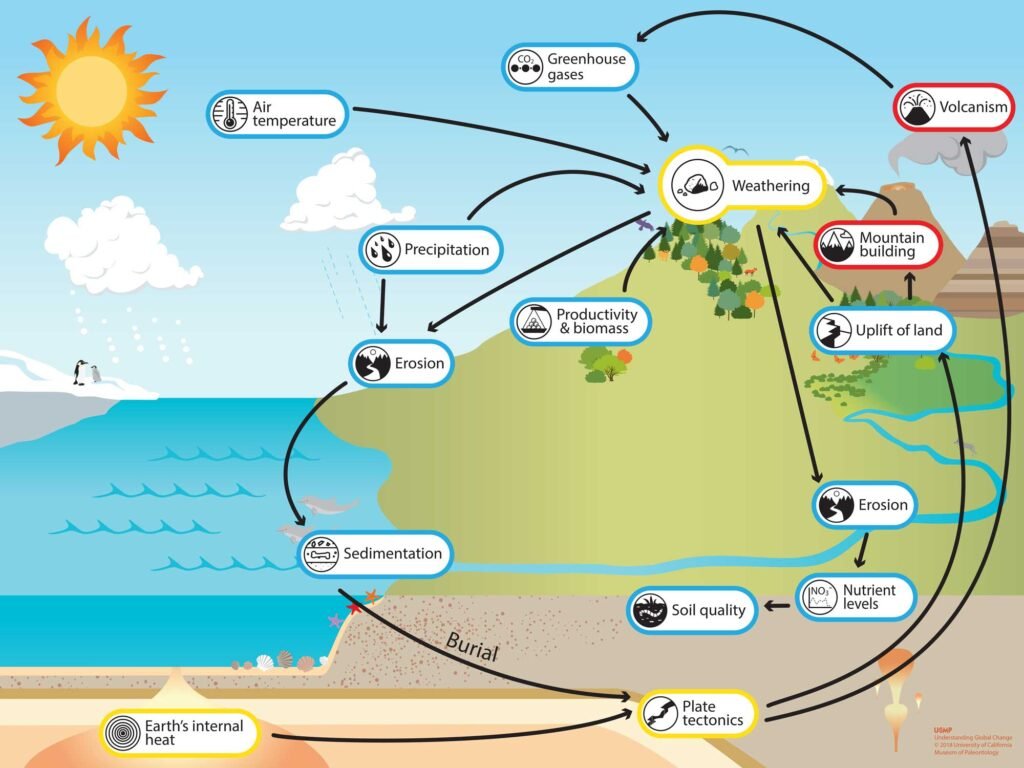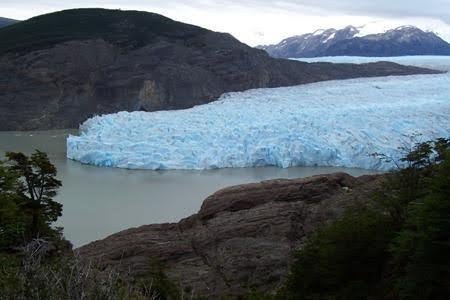Explore the fascinating world of Earth’s ever-changing landscapes as wind, water, and ice sculpt its surface through erosion. Delve into the dynamic forces that shape our planet, witnessing the strict dance of nature at play. From wind-blown deserts to water-carved canyons and icy formations, discover the powerful processes that mould Earth’s diverse terrains. Reveal the secrets of erosion as a natural artist, constantly reshaping the canvas of our world. Join the journey to understand the fascinating interplay between these fundamental forces, showcasing the continuous transformation of Earth’s breathtaking scenery.
Introduction: Understanding Erosion
The erosion, a natural wonder with deep importance, serves as a fundamental force continually sculpting our world. This relentless process, often underestimated in its impact, involves gradually wearing away of Earth’s surface by various agents such as wind, water, and ice. The understanding of erosion is important, as it reveals the transformative power inherent in clearly gentle elements.
Water erosion, driven by rivers and rainfall, shapes landscapes over time, carving valleys and canyons. Wind erosion, a quiet yet constant force, sculpts deserts and dunes through the removal of particles of ice erosion, prominent in colder regions, moulds mountains and valleys with the movement of glaciers. The effects of erosion extend far beyond the physical alteration of landforms it affects ecosystems, agriculture, and human settlements.

Wind Erosion: The Invisible Sculptor
Wind erosion, often ignored, acts as an invisible sculptor shaping landscapes through the gentle caress of air currents. This natural wonder quietly transforms the earth’s surface, leaving an unforgettable mark on landscapes worldwide.
The dance of wind particles carries tiny rubbing agents like sand and dust, sculpting rocks and soil over time. Wind erosion takes centre location in dry regions where vegetation struggles to land the soil. The determined force of wind mixes loose particles, creating stunning features like dunes and amazing rock shapes.
Water Erosion: The Art of Flowing Water
Water erosion is a stunning process that sculpts landscapes through the rhythmic dance of rivers and streams. As water curves, it globally an creative influence on the landscape, shaping valleys, canyons, and plains. Rivers and streams, like nature’s sculptors, carry sediments and waste downstream, slowly carving complex patterns into the earth.
With their constant flow, rivers cut through rocks, creating valleys that showcase the passage of time in the layers of sediment exposed. The streams, though gentler, contribute to the artistic canvas by rusting banks and depositing fertile soils. The continuous movement of water, sometimes a gentle caress and other times a forceful surge, paints a masterpiece of geological diversity.
The Erosion also plays a role in ecosystem dynamics, influencing habitats for various species. The interconnected web of life depends on the evolving landscape crafted by flowing water. In nature, the skill of water erosion is a testament to the dynamic, ever-changing nature of our planet, where rivers and streams are the skilled craftspeople shaping the Earth’s surface with their patient, steady strokes.
Ice Erosion: The Mighty Glacier’s Role

The Glacial movements wield huge power, shaping landscapes through a process known as ice erosion. This mighty glaciers, colossal rivers of ice, slowly advance and retreat, transforming the Earth’s surface. As glaciers move, they act as nature’s sculptors, carving valleys, fjords, and mountains over vast periods.
The primary force behind glacial erosion is scrape. As glaciers inch forward, embedded rocks and waste in their base act like sandpaper, grinding against the bedrock. This abrasive action smoothens and deepens valleys, leaving behind U-shaped formations that distinguish glacially carved landscapes.
Furthermore, plucking occurs as glaciers freeze onto rock surfaces and then rip loose rocks from the bedrock. This process transports large boulders and sediments, contributing to the geological transformation of the regions they traverse.
Ultimately, the impact of ice erosion extends beyond visual aesthetics, influencing ecosystems and hydrology. Glacial meltwater feeds rivers and lakes, sustaining life downstream. Understanding the mighty glacier’s role in shaping the land unlocks insights into Earth’s dynamic geological history.
Comparing Erosive Forces

Erosive forces play an important role in shaping the Earth’s landscapes, with wind, water, and ice each contributing distinct characteristics to the process of landscape change. These forces operate over different spatial and temporal scales, influencing landforms in diverse ways.
Wind erosion is mostly a mechanical process where abrasive particles carried by the wind impact and wear away exposed surfaces. It tends to be most prominent in arid regions, sculpting features like sand dunes and ventifacts. The effects of wind erosion are often visible on a smaller scale, with rocks and cliffs showcasing intricate patterns of graze.
Water, in the form of rivers, streams, and rainfall, is a potent agent of erosion, acting both mechanically and chemically. Water erosion shapes landscapes through processes such as fluvial erosion, which carves river valleys, and chemical weathering, which dissolves and alters rock formations. River channels evolve over time, meandering or cutting through the landscape, leaving behind intricate patterns of erosion and deposition.
Ice erosion, typically associated with glaciers, possesses immense power to shape the Earth’s surface. Glacial erosion is a slow but relentless force that sculpts valleys and fjords, leaving behind characteristic U-shaped profiles. As glaciers move, they pluck rocks from the underlying substrate, transporting and depositing them as moraines.
In ending, wind, water, and ice each exert unique erosive forces on the landscape, contributing to the dynamic evolution of the Earth’s surface. The interplay of these forces results in a rich tapestry of landforms, showcasing the intricate dance between geological processes and environmental conditions.
Erosion’s Role in Environmental Balance
Erosion’s Role in Environmental Balance: Benefits and Challenges
Benefits of Erosion:
- Soil Formation: Erosion contributes to the breakdown of rocks, facilitating soil formation by creating a mix of mineral particles, organic matter, and nutrients.
- Nutrient Cycling: Erosion transports essential nutrients across landscapes, aiding in nutrient cycling and enhancing soil fertility in different regions.
- Landscaping and Topography: Erosion shapes the Earth’s surface, creating diverse landscapes, valleys, and landforms that support various ecosystems and habitats.
- River and Stream Dynamics: Erosion is a natural process that shapes riverbanks and stream channels, creating diverse habitats for aquatic organisms and influencing the flow of water.
- Natural Geological Processes: Erosion is an integral part of geological processes, helping to balance the Earth’s surface features over geological timescales.
- Renewal of Sediment and Nutrient Sources: Erosion fills sediment and nutrient sources, supporting ecosystems by ensuring a continuous supply of essential elements.
- Ecological Succession: Erosion can initiate ecological succession by creating bare substrates, facilitating the colonisation of pioneer species and the development of diverse ecosystems.
- Natural Resource Redistribution: Erosion redistributes minerals and resources, aiding in the availability of essential elements for plant growth and ecosystem functioning.
Challenges of Erosion:
- Soil Degradation: Intense erosion can lead to soil degradation, compromising its structure, fertility, and ability to support plant life.
- Loss of Arable Land: Excessive erosion can result in the loss of arable land, impacting agricultural productivity and food security.
- Water Quality Issues: Erosion can contribute to sedimentation in water bodies, leading to water quality issues such as turbidity and the transport of pollutants.
- Habitat Destruction: Rapid erosion may destroy habitats, threatening the survival of various plant and animal species, especially those dependent on stable ecosystems.
- Increased Flooding Risk: Erosion can alter river and stream channels, increasing the risk of flooding as water is less effectively contained within natural channels.
- Infrastructure Damage: Erosion poses a threat to infrastructure, as it can undermine foundations, damage roads, and impact the stability of structures.
- Negative Impact on Water Resources: Excessive erosion can reduce the capacity of reservoirs and impact water supply systems by filling them with sediment.
- Loss of Biodiversity: Erosion-induced habitat destruction and changes in landscapes can lead to a loss of biodiversity as species lose their natural habitats.
- Cultural Heritage Impact: Erosion can affect archaeological sites and cultural heritage, leading to the loss of historically significant landscapes.
- Climate Change Amplification: Accelerated erosion can contribute to climate change by releasing stored carbon and impacting the balance of greenhouse gases in the atmosphere.

Human Impact on Natural Erosion
Human activities greatly accelerate natural erosion processes. Deforestation, for example, removes vegetation as a natural barrier against soil erosion, exposing the soil to the erosive forces of wind and water. Agriculture practices, such as improper ploughing and overgrazing, disturb the soil structure, making it more susceptible to erosion.
Urbanisation further exacerbates erosion as the construction of roads and buildings disrupts natural drainage patterns. Impermeable surfaces like pavement prevent water from infiltrating the soil, increasing surface runoff and erosion.
Mining activities strip away vegetation and expose large areas of land to erosion, especially in fragile ecosystems. Additionally, climate change induced by human activities intensifies extreme weather events, including storms and heavy rainfall, which contribute to accelerated erosion rates.
Improper waste disposal, such as dumping in riverbeds and coastal areas, introduces pollutants that degrade soil quality and exacerbate erosion. Overall, human actions, from land use changes to industrial practices, play a substantial role in hastening natural erosion processes, causing widespread environmental degradation and loss of fertile soil.
For more educational content that nurtures curiosity and learning, I encourage you to visit Chrysalis High.


